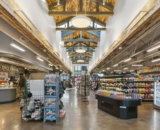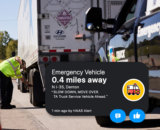For cashiers at Stamart Travel Centers, increasing the average sale per customer has been as simple as asking if shoppers would like to take advantage of a 99-cent bag of licorice. While that 99-cent purchase may seem small, suggestive selling—the process of recommending items to customers to spur an additional purchase— has the potential to add up to large profits for the locations.
Darren Schulte, vice president of membership for NATSO, said, “It can often be in the hundreds of thousands of dollars for one single item. If your location has 900 customer transactions a day and you had a 25 percent success rate of suggesting a $1.79 large candy bar to each customer, you would garner an additional $400 in sales for the day, $2,800 for the week, roughly $12,000 for the month and $147,000 for the year.”
What’s even better is that suggestive selling, also called upselling, can also improve shoppers’ overall experience at the location. Providing customers with money-saving opportunities or the information that allows them to make informed purchases increases customers’ perception that they received personalized attention and value at the location, which in turn can make them more invested in your location and repeat customers.
The Many Faces Of Suggestive Selling
To boost sales, operators can implement one or more of the four different types of suggestive selling. They include:
Conjunction: Suggesting an item in conjunction with a current purchase, such as asking if the customer would like to add a bag of chips to his 20-oz. bottle of soda.
Promotion: Suggesting that the customer take advantage of an item that is currently on sale.
Suggestive Selling: Suggesting customers take advantage of a larger size. For example, ask them if they would like to buy the king-size candy bar instead of the normal size.
Target: Suggesting that the customer buys a certain item. This item is usually chosen by the manager and changes on a routine basis.
As an added bonus, Schulte said suggestive selling can minimize theft. “If you’re suggestive selling, you’re greeting customers when they come in, you’re having conversations with them, and you’re paying attention to merchandise,” he said (see related article on reducing theft at your truckstop here).
Lisa Beach, retail operations manager for Stamart, said, “We have the licorice by the till and the cashiers will ask our customers if they want to buy a bag,” she said. “A lot of times people will take it and your average sale per customer goes up a little bit.”
For operators, suggestive selling is one of the easiest, most cost-effective ways to increase revenue, profit and customer satisfaction. Recently a Gallup Global Management study found it costs five times as much to gain a new client than it does to serve an existing one.
“It is harder to get new customers, so you can focus on getting more money from those existing customers,” Schulte said.
Sam Roark, director of operations for Affinity Gaming, which operates a truckstop at Whiskey Pete’s Resort and Casino, said, “You need to concentrate on the customer. They’re there already and purchasing something from you. If the opportunity arises to upsell them into a better unit by listening to what they want, you capitalize on it.”
The top items for a suggestive selling program are those that easily fit on the counter and are something cashiers have an easy time asking someone to buy. “If it is a stand-alone program, candy works well. If it is an associated purchase, it makes it easier from a selling standpoint. If your program is lighters and your suggestive sell is every time someone buys cigarettes you suggest a lighter, that is an easy program,” Schulte said.
Schulte added that retailers need to be mindful of how many items they feature by the register. “If your counter is cluttered with all kinds of items and you have an upsell item you’re trying to sell there, you minimize the effectiveness of the program,” he said.
The recent licorice promotion isn’t the first time Stamart has turned to suggestive selling, and over the years Beach has learned what works and what doesn’t. “We know we have to keep it simple and low priced, so food and candy seem to work the best,” she said, adding that Stamart has had success suggestive selling items in the restaurant. “We introduced a new meatloaf sandwich into our mix of food and some of our customers are choosing that for $3.99 over the $1.50 hamburger. The margin on the hamburger is 50 percent and the meatloaf is 56 percent. The meatloaf sandwich is very simple to make and there is not a lot of labor involved.”
Stamart has also introduced wraps for $1.29. “We have a breakfast wrap and a chicken and hamburger wrap. Customers might grab a breakfast pizza, but they want a little bit more so they grab a wrap, too,” Beach said.
For Roark, suggestive selling electronics has proven to be the most profitable. “It is your highest retail ring and it is the easiest to upsell on. Whether it is a radar detector, a CB, laptops or tablets, they’re the easiest to close. The customer is already in there to get that specific item from you and it’s easier than you think,” he said.
Electronics are also higher ticket items. “Gloves are a $7.99 ring versus a $200 ring in electronics. You get greater gross margin dollar production,” Roark said.
However, suggestive selling on electronics will only work if retailers understand the products. Roark said employees take time to read the product sheets and learn the features of each product.
Don Paddock, president of KSG, said, “With the big increase in hands-free devices or mobile phones, you generally have three items—a entry level, midlevel and premium level. People will look at the entry level, but we let the personnel know about the features of the other devices so they can help the customers find what they’re looking for.”
Operators can also spur sales by offering multi-price discounts, and vendors may be able to help with point-of-sale signage to draw attention to specials.
KSG offers displays and point-of-sale signage to spotlight discounts on DVD purchases. “We see a 15 to 20 percent lift when we offer two for $20 pricing and a 35 percent increase when we offer four or five DVDs for $20,” said Paddock. “Sometimes we’ll also do buttons that say ‘ask me about ______.”
Communication is the key to a sale, whether it is the cashier passing along info to a customer or a vendor passing along information to the location buyer.
Kevin Puebla, national account manager, DAS, said his salespeople talk over new promotions with the travel plaza manager to boost the energy level surrounding a product. “You have to show excitement to the manager. Too often it just becomes the same old same old and there isn’t much discussion,” he said. “If we create excitement with the managers, they’ll pass that excitement on to their people.”
By working together, vendors and operators can boost overall sales. “We’re partners with them so we have to act like we’re partners,” Puebla said.
DAS’s sales staff work to ensure store displays are set up correctly and that displays and flyers are in high-traffic areas so customers can see the promotions. “If we’re doing a promotion on an end cap, we’ll have it planogrammed for the location. It shows where it should go and how it will look the best,” Puebla said.
The keys to any suggestive selling program are the front-line employees. To get them invested in the promotions, some locations offer contests. “The main thing is to get them excited and taking part in it,” Beach said. In the past, Stamart has offered a $50 Stamart gift card to the employee who sells the most of a particular item within a certain period of time. “You have to give them a reason to do it and you have to make it fun, otherwise they feel like they’re bugging the customer,” she said.
Money is typically the best motivator for employees, Schulte said. “Traditionally, employees sign into the register using their code and then the point-of-sale system tracks the number of units sold,” he explained.
Beach said cashiers should approach suggestive selling with a positive attitude. “It is important to train your cashiers to do it right. It takes managers getting involved and showing them how to do it and promoting the right priced item.”
Roark told Stop Watch employee training is important. “You need to have that person with you on the floor when you’re selling so they see you do it,” he said.
Schulte said he expects suggestive selling to become even more important as more and more people shop online. “Everyone is finally realizing that when a customer comes into your store, you better try to get as much sell out of that person as you can. I even believe in the future, the registers will tell the cashier what to upsell,” Schulte said.
Quick Tips For Effective Suggestive Selling
Help influence customers to do more business with you with these four tips.
Target Specific Products: To increase a program’s effectiveness, ensure any suggestive selling program is a focused program. For example, a location might have a dozen buy-one-get-one-half-off specials going on at one time, but it could be difficult for cashiers to remember every promotion. Management can choose two of the promotions they want cashiers to focus on and try to boost sales in those specific areas.
Know What Your Customers Need: Talking with your customers will help you understand the products they need and want to buy (see related story on Trends and Priorities Affecting the Travel Plaza and Truckstop Industry). By listening to what they have to say and paying attention to what they’re already buying, you can identify the suggestive selling opportunities that will provide value.
Sell Solutions: By knowing what your customers need, you can offer them meaningful solutions that best meet their needs. For example, a driver that is picking up coffee may be receptive if the cashier recommends a pastry to go with it. A customer shopping for a GPS will appreciate an employee who can tell him about the features of the different options.
Educate Customers: Shoppers looking at products with higher price points, such as electronics, will be able to make better buying decisions if they know the advantages of the different options. By pointing out the features of products and helping shoppers determine the benefits, employees have a better opportunity to make a larger sale and provide greater customer service.
|
Join the conversation! Share your ideas on what does and doesn’t work for suggestive selling in the comment section below.
|
Photo Credit: Ira Wexler/NATSO
|
This article originally ran in Stop Watch magazine. Stop Watch provides in-depth content to assist NATSO members in improving their travel plaza business operations and provides context on trends and news affecting the industry. The magazine is mailed to NATSO members bimonthly. If you are a member and not receiving Stop Watch, submit a request to be added to the mailing list. Not a member? Join today or submit a request to receive additional information. |
Subscribe to Updates
NATSO provides a breadth of information created to strengthen travel plazas’ ability to meet the needs of the travelling public in an age of disruption. This includes knowledge filled blog posts, articles and publications. If you would like to receive a digest of blog post and articles directly in your inbox, please provide your name, email and the frequency of the updates you want to receive the email digest.

